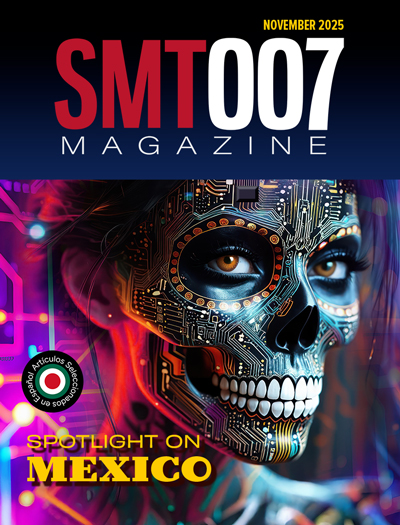-

-
News
News Highlights
- Books
Featured Books
- smt007 Magazine
Latest Issues
Current Issue
Spotlight on Mexico
Mexico isn’t just part of the electronics manufacturing conversation—it’s leading it. From growing investments to cross-border collaborations, Mexico is fast becoming the center of electronics in North America. This issue includes bilingual content, with all feature articles available in both English and Spanish.

Production Software Integration
EMS companies need advanced software systems to thrive and compete. But these systems require significant effort to integrate and deploy. What is the reality, and how can we make it easier for everyone?

Spotlight on India
We invite you on a virtual tour of India’s thriving ecosystem, guided by the Global Electronics Association’s India office staff, who share their insights into the region’s growth and opportunities.
- Articles
- Columns
- Links
- Media kit
||| MENU - smt007 Magazine
Tips & Tricks: Wave Solder Bridging
April 3, 2019 | Jason Fullerton, MacDermid Alpha Electronics SolutionsEstimated reading time: 1 minute
Wave solder bridging is the most difficult defect to troubleshoot because it has a number of potential causes. The key is to understand the role of flux during wave contact—reducing the surface tension of the solder to reduce the tendency to bridge between pins as the board leaves the wave. Bridging occurs when the flux has been chemically depleted before exiting the wave. This can be a function of the flux and process.
With respect to flux, in general, fluxes with higher activity levels are more resistant to bridging. This means that no-clean fluxes can be more likely to result in bridging, especially with older formulations. Newer flux formulations are available that have higher levels of performance while still meeting the requirements of no-clean classification.
Regarding the process, the flux loading and total thermal input to the board are key factors. An inadequate amount of flux can result in flux exhaustion before wave exit. Excessively high thermal inputs can also lead to bridging with three factors to measure. Preheat temperature is the first, contact time on the wave is the second, and solder pot temperature is the third. The optimal values for each should be available on the data sheet for any flux, and they will be different for every flux formulation.
There are other reasons outside of flux and process that can lead to bridging. The design of masking pallets can cause bridging if there is inadequate clearance around the devices. The PCB layout can also cause bridging if rows of leads are unable to be processed through the wave in the proper orientation (orthogonally and not parallel to the wave). These factors may not be able to be overcome through process optimizations or flux selection.
Jason Fullerton is the customer technical support engineer at the Assembly Division of MacDermid Alpha Electronics Solutions.
Testimonial
"The I-Connect007 team is outstanding—kind, responsive, and a true marketing partner. Their design team created fresh, eye-catching ads, and their editorial support polished our content to let our brand shine. Thank you all! "
Sweeney Ng - CEE PCBSuggested Items
BTU International Earns 2025 Step-by-Step Excellence Award for Its Aqua Scrub™ Flux Management System
10/29/2025 | BTU International, Inc.BTU International, Inc., a leading supplier of advanced thermal processing equipment for the electronics manufacturing market, has been recognized with a 2025 Step-by-Step Excellence Award (SbSEA) for its Aqua Scrub™ Flux Management Technology, featured on the company’s Pyramax™ and Aurora™ reflow ovens.
On the Line With… Ultra HDI Podcast—Episode 7: “Solder Mask: Beyond the Traces,” Now Available
10/31/2025 | I-Connect007I-Connect007 is excited to announce the release of the seventh episode of its 12-part podcast series, On the Line With… American Standard Circuits: Ultra HDI. In this episode, “Solder Mask: Beyond the Traces,” host Nolan Johnson sits down with John Johnson, Director of Quality and Advanced Technology at American Standard Circuits, to explore the essential role that solder mask plays in the Ultra HDI (UHDI) manufacturing process.
Rehm Wins Mexico Technology Award for CondensoXLine with Formic Acid
10/17/2025 | Rehm Thermal SystemsModern electronics manufacturing requires technologies with high reliability. By using formic acid in convection, condensation, and contact soldering, Rehm Thermal Systems’ equipment ensures reliable, void-free solder joints — even when using flux-free solder pastes.
Indium Experts to Deliver Technical Presentations at SMTA International
10/14/2025 | Indium CorporationAs one of the leading materials providers to the power electronics assembly industry, Indium Corporation experts will share their technical insight on a wide range of innovative solder solutions at SMTA International (SMTAI), to be held October 19-23 in Rosemont, Illinois.
Knocking Down the Bone Pile: Revamp Your Components with BGA Reballing
10/14/2025 | Nash Bell -- Column: Knocking Down the Bone PileBall grid array (BGA) components evolved from pin grid array (PGA) devices, carrying over many of the same electrical benefits while introducing a more compact and efficient interconnect format. Instead of discrete leads, BGAs rely on solder balls on the underside of the package to connect to the PCB. In some advanced designs, solder balls are on both the PCB and the BGA package. In stacked configurations, such as package-on-package (PoP), these solder balls also interconnect multiple packages, enabling higher functionality in a smaller footprint.


